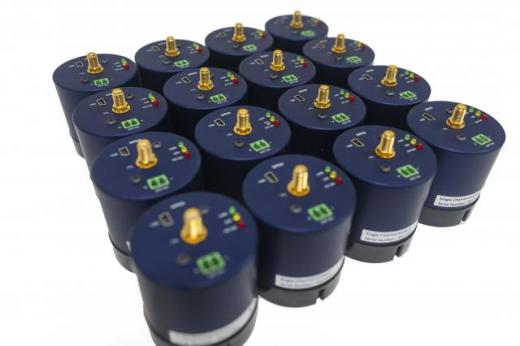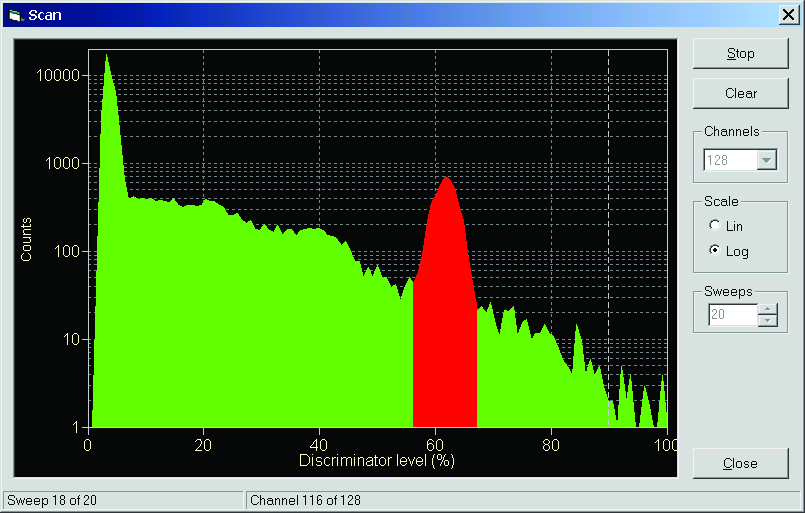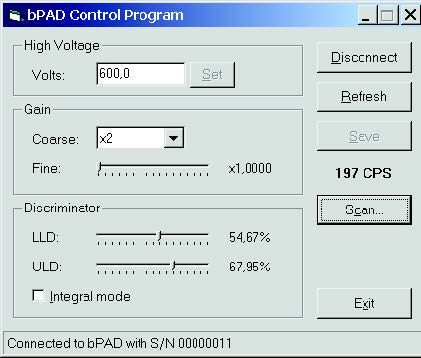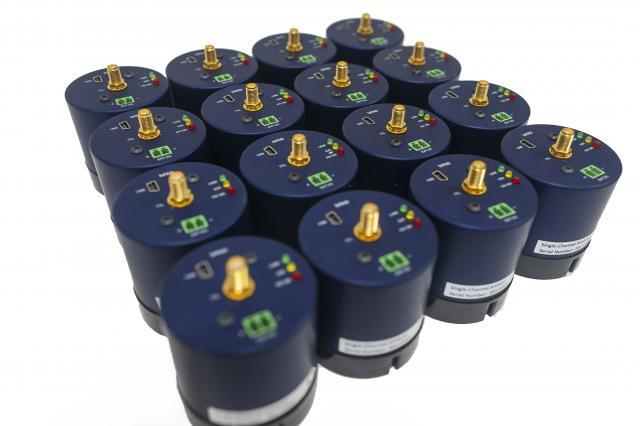
The bPAD is a microprocessor based Single Channel Analyzer (SCA) that incorporates a preamplifier, an amplifier, and a discriminator in a compact photomultiplier tube base. The bPAD also includes its own programmable high voltage power supply allowing for the operation of a broad range of standard 14-pin photomultiplier tubes used with scintillation type radiation detectors (e.g. PVC, NaI(Tl), LaBr, CeBr3, etc).
The bPAD is particularly useful as a compact system for the monitor of count rates in an energy region of interest. The detected signal is output as a TTL pulse, making it compatible with most industrial, environmental, and laboratory counting systems. In contrast with traditional SCAs, the bPAD is fully controlled by a microprocessor allowing for easy setup and “smart” modes of operations. The bPAD’s parameters can be conveniently set via USB with a PC and the provided configuration software.
Overview
The bPAD is an advanced, microprocessor-based Single Channel Analyzer (SCA) that integrates a charge-sensitive preamplifier, a variable-gain amplifier, and a window discriminator all in a compact 14-pin photomultiplier tube base. The bPAD outputs a TTL pulse per photo-event detected by a scintillation detector in the energy range of interest.
The bPAD also includes a miniature, programmable, and efficient high-voltage supply that provide the power necessary to operate the most widespread range of photomultiplier tubes used with scintillation detectors. The output voltage can be set in the range from 0 to 1500 Volts with a resolution of 4096 steps.
Since the device is microprocessor-controlled, the bPAD benefits from being easy to setup. The device connects to a PC via its USB interface. By using the provided software, all the operational settings can be configured and fine-tuned for any kind of scintillation detector. Once the setup is complete, all the settings are saved into the device’s non-volatile memory.
The PC software also comes with a “pseudo-PHA” acquisition mode. In this mode, the software slides the single-channel window over the whole input range constructing an energy spectrum. By using this spectrum, the user can visually identify the energy range of interest and immediately set the boundaries of the bPAD discriminator window. This represents a large improvement over the traditional “blind” method used with most other SCAs.
The bPAD has two modes of operation:
- Integral, where counts are output for signals above a single energy threshold level
- Differential, where counts are output for signals within a defined energy window (SCA)
The output pulses correspond to counted events in the energy window of interest. They are 5-volt TTL signals with 2.5 µsec duration. The bPAD can also be ordered to output pulses with a duration of 10 µsec instead.
The bPAD can be powered via the USB connection or by an external DC power supply of 6 to 36 volts. Three color LEDs are used for status indications: Red for detector high voltage, Yellow for incoming count rate (ICR), and Green for power and communication status.
The bPAD is very compact with a size of 65 mm diameter by 71 mm high (60 mm not counting the TTL output connector) and weighs less than 80 grams.


Options
bPAD+
The bPAD+ is an enhanced version of the bPAD intelligent Single-Channel Analyzer. The bPAD+ adds an extra analog pulse output, which can be connected to an external MCA for monitoring purposes. Being fully digital, the bPAD+ benefits from the same advantages of the bPAD.
bPAD+VR
The bPAD+VR is an enhanced version of the bPAD+ intelligent Single-Channel Analyzer. In this design, the analog output can be configured to deliver the pulse signal as in the bPAD+, or a variable voltage level which is proportional to the discriminated count rate. This feature is useful in flow count rate instruments or HPLC systems, for example.
bPAD/VR/HPLC
Same as the bPAD+VR but with multi-parameter setup software for HPLC applications.
Device and Digital Settings
- Acquisition modes: Integral and differential
- Coarse gain: x1, x2, x4, x8 (optional: x16, x32, x64, x128)
- Fine gain: x1...x2 in 4096 steps
- Upper and Lower Level discriminator resolution: 2048 steps
- Output: 5 Volts TTL signals of 2.5 µsec duration.
High Voltage Power Supply
- Miniature HV power supply embedded into the device assembly
- Voltage: 0 to 1 500 Volts in 4096 steps
Data Communication
- USB 2.0, cable included
- TTL output via SMA connector, cable included
Physical
- USB connector: type mini B, used for PC communication or power
- Power connector: pluggable terminal block, 6 to 36 Volts, plug included
- Power consumption: 1 watt maximum
- Size: Height 71 mm, Diameter 56 mm
- Weight: Approximately 80 grams
Indicators
- Red LED for detector high voltage
- Yellow LED for incoming count rate (ICR)
- Green LED for power and communication status
Other
- The device is supplied with Windows PC software for setup and pseudo-PHA
- The software can also display the CPS value for the defined SCA region
Certifications
- The device is CE compliant
Downloadable resources such as datasheets, firmware, software, drivers and products manuals. Alternatively, you can browse resources directly by visiting our downloads page.
• Product Datasheets
• Product Firmware
• Product Software and Drivers
• Product Manuals
Price List
Price lists are available to our registered users. To view pricing for this and other products, please log in or create a free account.


